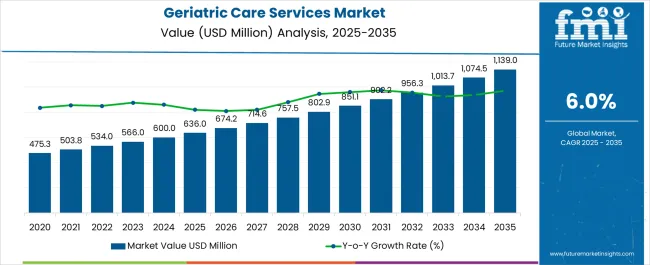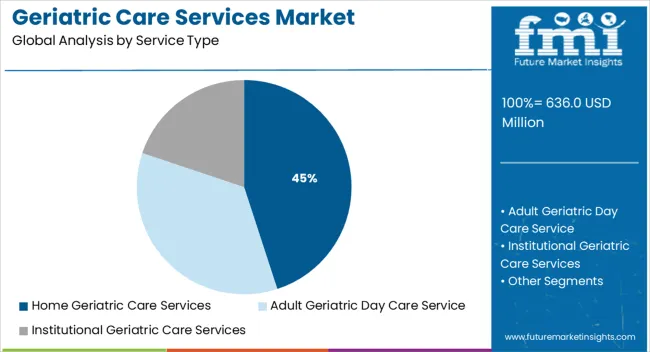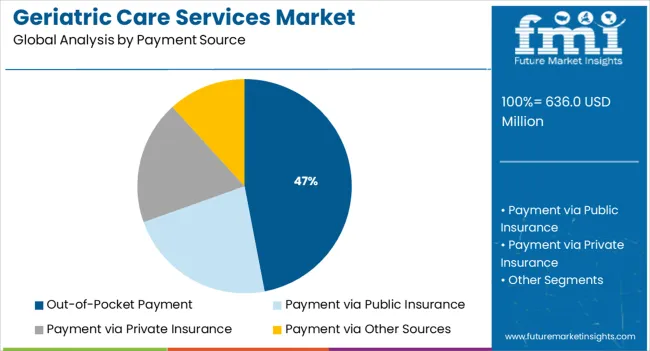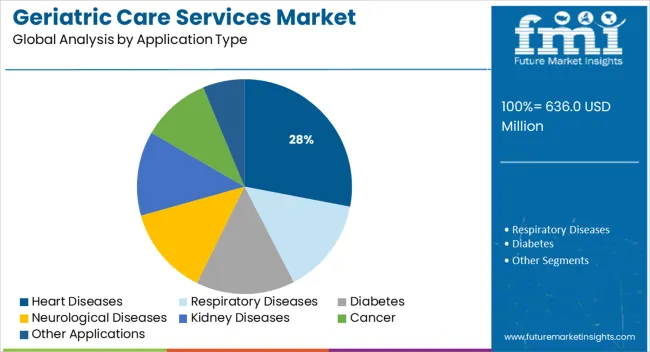The Geriatric Care Services Market is estimated to be valued at USD 636.0 million in 2025 and is projected to reach USD 1139.0 million by 2035, registering a compound annual growth rate (CAGR) of 6.0% over the forecast period.

| Metric | Value |
|---|---|
| Geriatric Care Services Market Estimated Value in (2025 E) | USD 636.0 million |
| Geriatric Care Services Market Forecast Value in (2035 F) | USD 1139.0 million |
| Forecast CAGR (2025 to 2035) | 6.0% |
The geriatric care services market is experiencing significant expansion driven by the increasing aging population worldwide, rising prevalence of chronic diseases, and growing preference for home-based healthcare. Enhanced awareness of elderly care and improved healthcare infrastructure have increased access to personalized services.
Payment dynamics are evolving as out-of-pocket expenditures remain dominant due to limited insurance penetration, yet efforts toward expanding coverage are underway. Technological advancements in telemedicine and remote monitoring are facilitating better patient management and caregiver support, improving quality of life.
Future growth is anticipated from integrated care models that address multi-morbidity and cognitive disorders, alongside policy initiatives promoting aging-in-place strategies. The market’s evolution is further supported by the increasing role of private providers and community-based organizations tailoring services to elderly needs..
The market is segmented by Service Type, Payment Source, and Application Type and region. By Service Type, the market is divided into Home Geriatric Care Services, Adult Geriatric Day Care Service, and Institutional Geriatric Care Services. In terms of Payment Source, the market is classified into Out-of-Pocket Payment, Payment via Public Insurance, Payment via Private Insurance, and Payment via Other Sources. Based on Application Type, the market is segmented into Heart Diseases, Respiratory Diseases, Diabetes, Neurological Diseases, Kidney Diseases, Cancer, and Other Applications. Regionally, the market is classified into North America, Latin America, Western Europe, Eastern Europe, Balkan & Baltic Countries, Russia & Belarus, Central Asia, East Asia, South Asia & Pacific, and the Middle East & Africa.

Home geriatric care services are expected to hold 45.0% of the total revenue share in 2025, making it the leading service type segment. This growth is driven by the convenience and personalized attention afforded by in-home care, which aligns with elderly preferences for aging in familiar surroundings.
The segment benefits from reduced hospitalization rates and better chronic disease management enabled through regular home visits and telehealth support. Increasing caregiver availability and acceptance of home care models by healthcare payers have contributed to its expansion.
Additionally, home care facilitates cost containment for families and healthcare systems while enhancing patient comfort and autonomy, factors that sustain the segment’s dominant position..

Out-of-pocket payment is projected to represent 47.0% of the market revenue share in 2025, establishing it as the leading payment source in geriatric care services. This prevalence is attributed to the limited penetration of public and private insurance schemes covering elderly care, especially in emerging economies.
The direct payment model provides flexibility in choosing service providers and customizing care plans but poses affordability challenges for some segments. Despite these barriers, growing disposable incomes and prioritization of elderly health spending have supported continued reliance on out-of-pocket payments.
Policy efforts to enhance insurance coverage and government subsidies are expected to gradually shift the payment landscape, though out-of-pocket will likely remain significant in the near term..

The heart diseases segment is anticipated to contribute 28.0% of the overall application revenue share in 2025, ranking it as the top application category within geriatric care services. This prominence stems from the high prevalence of cardiovascular conditions among the elderly, necessitating continuous monitoring and specialized interventions.
Advances in remote cardiac monitoring devices and personalized medication management have improved patient outcomes, supporting service demand. Care programs targeting heart disease focus on reducing hospital readmissions and enhancing rehabilitation, aligning with preventive care models.
The segment also benefits from increased funding and awareness campaigns emphasizing early diagnosis and lifestyle modification in aging populations, reinforcing its leading market position..
According to the Centres for Disease Control and Prevention’s Estimates in 2014, the number of patients who received care worldwide was around 4.9 million in 2013, with 12,400 home healthcare agencies in the USA The USA is expected to hold a significant position in the global geriatric care services market, experiencing a CAGR of 6.9% during the forecast period, and is expected to reach a valuation of USD 332.5 Million.
Strategic initiatives by key players have also fueled market growth. For instance, in March 2025, Alexion, AstraZeneca’s Rare Disease group, closed an exclusive global collaboration and license agreement with Neurimmune AG for NI006, an investigational human monoclonal antibody currently in Phase Ib development for the treatment of transthyretin amyloid cardiomyopathy (ATTR-CM), an underdiagnosed, systemic condition that leads to progressive heart failure and high rate of fatality within four years from diagnosis.
Manufacturers are working hard for research and development of innovative offerings to serve a large customer base and that will allow the geriatric care services market to grow. Hence, manufacturers are adopting strategies such as mergers & acquisitions to expand their global footprint and add disruptive advancements to their product portfolio.
Further, a number of international market participants are entering into acquisitions and mergers and implementing new technology to increase commercial capacity to gain a major revenue share.
For instance, in January 2025, Century Therapeutics and Bristol Myers Squibb announced a research collaboration and license agreement (the Agreement) to develop and commercialize up to four induced pluripotent stem cell (iPSC) derived, engineered natural killer cell (iNK) and/or T cell (IT) programs for hematologic malignancies and solid tumors.
The first two programs include a program in acute myeloid leukemia and a program in multiple myeloma, which could incorporate either the iNK or a gamma delta iT platform. Bristol Myers Squibb has the option to add two additional programs which can be nominated subject to certain conditions agreed with Century in the agreement.
Growing Demand for Home Care Services for Elderly People
The growing demand for home care services for elderly people is a significant factor driving the Elderly Care Products and Services market during the forecast period. The growing elderly population coupled with the rising demand for services for individuals suffering from chronic diseases that are above the age of 60 worldwide will further fuel the market growth.
In addition, the presence of a wide range of services within the domain of healthcare has also brought elderly care under the spotlight of attention. The presence of a sound healthcare industry is a prerequisite to the success of a nation’s economy.
Considering the aforementioned factors, the global market for geriatric care services is projected to expand at a starry rate in the years to come. Moreover, an increase in the population globally has ensured higher elder care thereby, the market is anticipated to grow in the upcoming years.
Technological Advancement and Product Innovation
Technological advancement and product innovation are some other factors that are expected to accelerate the Geriatric Care Services Market during the analysis period. Increasing product innovations including gadgets for emergency assistance, remote monitoring devices, and health monitoring wearable devices are increasing, which in turn helps to monitor the patient more efficiently with lesser effort.
In addition, new products such as grab bars, assistive sitting devices, toilet accessories, and others are contributing to the growth of the market.
Further, comorbidities such as diabetes, renal insufficiency, arthritis, and metabolic changes are quite common among the elderly population which makes them more susceptible to infection.
The combination of increased comorbid conditions and the decrease in the activity of the immune system of the elderly population is further driving the market for geriatric care services. Additionally, the recent technological evolution in geriatric care services will benefit the growth of the geriatric care services market in the upcoming years.
Absence of Proper Geriatric Care Services in Developing Countries
The lack of proper geriatric care services in developing countries is another major factor that is expected to hamper the growth of the geriatric care services market in the long run.
Violence continues to occur and is most prevalent in emergency departments, behavioral health facilities, intensive care units, waiting rooms, and geriatric care units. Approximately half of the nurses responding to a 2011 survey conducted by the Emergency Nurses Association (ENA) believe violence is simply part of their everyday work environment.
Between 8% and 13% of emergency room nurses are victims of physical violence every week. Thus, this violence can cause a bad shadow on Care services and people will not opt for them affecting the market growth.
Rising Awareness of Elderly Care to Fuel Market Growth
The contemporary-day changes in the healthcare setup have largely aided the growth of the global geriatric care services market. Furthermore, the importance given to healthcare management in recent times has also led to advancements in the field of elderly care. The rising incidence of chronic diseases that persist until people become old has also created commendable market growth.
The need for a functional domain for elderly care has been rising over the past decade. Governments are making ardent efforts to improve the quality of life for the geriatric population.
There is little contention that the global geriatric care services market would witness paced growth in the years to come. The medical reimbursement policies for the elderly have been improving over the past couple of decades. This factor has played an integral role in the growth of the global geriatric care services market.
The need for establishing better values and standards for the treatment of elderly people has also aided growth. It is expected that increasing investments in healthcare would lead to the inflow of voluminous revenues into the global geriatric care services market.
An increase in demand and preference for home care will fuel the market growth
As per the American Geriatrics Society, home care is associated with longer life and a reduced risk of re-hospitalization which will result in fostering the geriatric care services market progression during the forecast period.
Home care service-providing companies commonly work with families to make care plans for aged people. One of the advantages of hiring a home care company is its affordability along with caregivers that come on several days each week to assist seniors. Identifying the unmet care and support requirements of the geriatric population is becoming an urgent public health priority.
Adult daycare to witness considerable CAGR for the market growth
The adult daycare segment of the geriatric care services market accounts for the highest CAGR of 6.9% during the forecast period, as adult daycare enables the elderly to stay at home and receive the whole daycare without altering their lifestyles. Services include medical and non-medical services.
The rise in technological advancements in recent years has led to the launch of new products for self-monitoring, and multi-parameter diagnostic monitors. This resulted in high demand for such diagnostic equipment for adult day care, which in turn is driving the segment’s growth over the analysis period.
Diabetes likely to be the highest contributor to Market Growth
The diabetes segment of the geriatric care services market is expected to grow at the highest CAGR of 6.8% during the forecast period, attributed to the increasing number of diabetic patients.
Monitoring blood sugar at home helps arrive at an overall diabetes treatment plan and aids in managing the medications for blood sugar, diet, and exercise.
Converging Trends of the Aging Population to Widen Scope of the Market
North America holds a dominant position in the global geriatric care service market, owing to the increasing number of geriatric care agencies, converging trends of an aging population, favorable reimbursement policies, and technological advancements.
According to the Centres for Disease Control and Prevention’s Estimates in 2014, the number of patients who received care worldwide was around 4.9 million in 2013, with 12,400 home healthcare agencies in the USA.
The USA is expected to hold a significant position in the global geriatric care services market, experiencing a CAGR of 6.9% during the forecast period, and is expected to reach a valuation of USD 332.5 Million.
Geriatric Care Services Market in China to Witness Better Growth Opportunities
The Asia Pacific region is expected to grow at the highest CAGR during the forecast period, owing to the growing adoption of Geriatric Care Services. The number of older people in the Asia-Pacific region is growing at an unprecedented rate and it is at the forefront of the global phenomenon of the aging population.
In addition, the growing life expectancy, declining fertility rates, and geriatric care services are the key drivers of the aging population in some countries of the region. China is expected to represent the highest CAGR of 6.5% in the geriatric care services market during the forecast period and is expected to reach a valuation of USD 68 Million.
Whereas, Japan is expected to represent the highest CAGR of 5.4% in the geriatric care services market during the forecast period and is expected to reach a valuation of USD 54.9 Million.
Endo Pharmaceuticals Inc., Merck & Co. Inc., AstraZeneca PLC, Pfizer Inc., Allergan Inc., Bristol-Myers Squibb Company, Regeneron Pharmaceuticals Inc., AstraZeneca PLC, F. Hoffmann-La Roche AG, Octapharma AG, Epoch Elder Care, St Luke's ElderCare Ltd., Korian Group, and ProVita International Medical Center, among others, are the top companies in the global geriatric care services market.
With a sizable geriatric care services market share, these main firms are concentrating on growing their consumer base in new countries. These businesses are making use of strategic collaboration initiatives to grow their market share and profits.
Mid-size and smaller businesses, on the other hand, are expanding their market presence by gaining new contracts and entering new markets, thanks to technical developments and product innovations.
The global geriatric care services market is estimated to be valued at USD 636.0 million in 2025.
The market size for the geriatric care services market is projected to reach USD 1,139.0 million by 2035.
The geriatric care services market is expected to grow at a 6.0% CAGR between 2025 and 2035.
The key product types in geriatric care services market are home geriatric care services, adult geriatric day care service and institutional geriatric care services.
In terms of payment source, out-of-pocket payment segment to command 47.0% share in the geriatric care services market in 2025.






Full Research Suite comprises of:
Market outlook & trends analysis
Interviews & case studies
Strategic recommendations
Vendor profiles & capabilities analysis
5-year forecasts
8 regions and 60+ country-level data splits
Market segment data splits
12 months of continuous data updates
DELIVERED AS:
PDF EXCEL ONLINE
Suncare Products Market Size and Share Forecast Outlook 2025 to 2035
Skincare Supplement Market Size and Share Forecast Outlook 2025 to 2035
Skincare Oil Market Size and Share Forecast Outlook 2025 to 2035
Lip Care Market Analysis - Size and Share Forecast Outlook 2025 to 2035
Skincare Nutritional Serum Market Size and Share Forecast Outlook 2025 to 2035
Haircare Supplement Market - Size, Share, and Forecast Outlook 2025 to 2035
Skincare Products Market Size and Share Forecast Outlook 2025 to 2035
Lip Care Packaging Market Size and Share Forecast Outlook 2025 to 2035
Skincare Market Analysis - Size, Share, and Forecast Outlook 2025 to 2035
Sun Care Products Market Analysis – Growth, Applications & Outlook 2025–2035
Skincare Packaging Market Size, Share & Forecast 2025 to 2035
Pet Care Market Analysis – Demand, Trends & Forecast 2025–2035
Car Care Products Market Trends - Growth, Demand & Analysis 2025 to 2035
Pet Care Packaging Market Insights - Growth & Forecast 2025 to 2035
Eye Care Supplement Analysis by Ingredients, Dosage Form, Route of Administration, Indication, Distribution channel and Region 2025 to 2035
Homecare Medical Devices Market Outlook – Industry Growth & Forecast 2025 to 2035
Skincare Industry in India – Trends & Growth Forecast 2024-2034
Global Skincare Treatment Market Analysis – Size, Share & Forecast 2024-2034
Pet Care Ingredients Market
Homecare Dermatology Energy-based Devices Market Growth – Trends & Forecast 2018-2028

Thank you!
You will receive an email from our Business Development Manager. Please be sure to check your SPAM/JUNK folder too.
Chat With
MaRIA